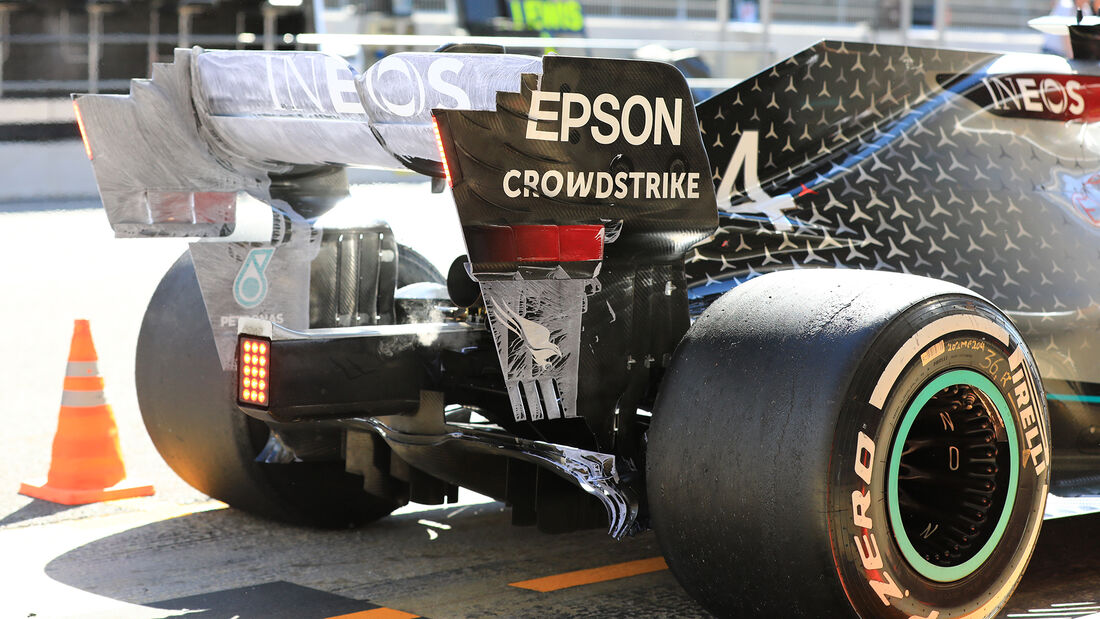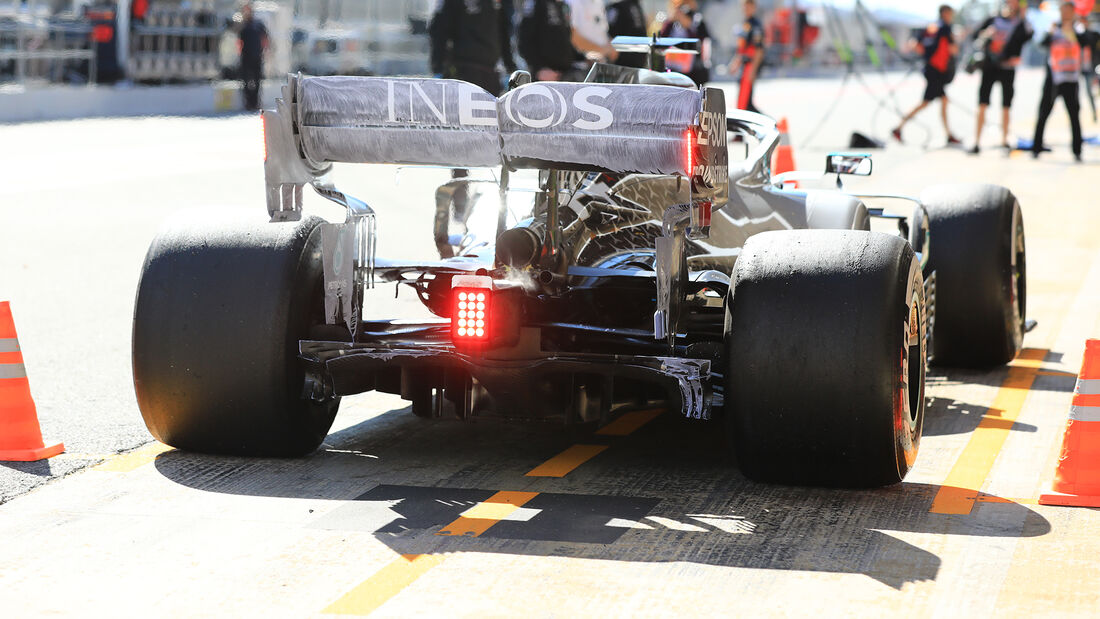- Login or Register
No account yet? Sign up

Nice. No separation...



There's a small trailing edge separation towards the tips on the flap. No stall. But small separation.

Gues that's normal! There should be some "rotor" forming behind in low pressure zone at the trailing edge. Similar to wind blowing over the ridge?jjn9128 wrote: ↑26 Feb 2020, 15:57There's a small trailing edge separation towards the tips on the flap. No stall. But small separation.
Not exactly. The rotor you're talking about forms behind the Gurney Flap (when the wing has one). So, engineers want to see a perferctly smooth flow on the wing's trailing edge, which is not the case for Mercedes right now.cirrusflyer wrote: ↑26 Feb 2020, 16:05Gues that's normal! There should be some "rotor" forming behind in low pressure zone at the trailing edge. Similar to wind blowing over the ridge?
The Mercedes is running a Gurney flap.variante wrote: ↑26 Feb 2020, 16:38Not exactly. The rotor you're talking about forms behind the Gurney Flap (when the wing has one).cirrusflyer wrote: ↑26 Feb 2020, 16:05Gues that's normal! There should be some "rotor" forming behind in low pressure zone at the trailing edge. Similar to wind blowing over the ridge?


There is some thinner layer of paint at the bottom of the flap. But air stays attached. I presume it is becouse air is rammed betwen RW (low part) and flap (upper part).Just_a_fan wrote: ↑26 Feb 2020, 16:55The Mercedes is running a Gurney flap.variante wrote: ↑26 Feb 2020, 16:38Not exactly. The rotor you're talking about forms behind the Gurney Flap (when the wing has one).cirrusflyer wrote: ↑26 Feb 2020, 16:05Gues that's normal! There should be some "rotor" forming behind in low pressure zone at the trailing edge. Similar to wind blowing over the ridge?
It looks like there is strong lateral movement just before the trailing edge out near the endplate. Presumably being driven by the same movement that creates the wing tip vortex.
That is normal, the plateau part of a wings incidence-lift curve features flow separation from the trailing edge - despite the separation downforce will continue to increase but at a slower rate. Once the separation is over a large proportion of the wings surface it is said to have stalled and downforce will rapidly drop off. This level of separation just means the wing is being operated near it's maximum angle.cirrusflyer wrote: ↑26 Feb 2020, 16:05Gues that's normal! There should be some "rotor" forming behind in low pressure zone at the trailing edge. Similar to wind blowing over the ridge?
Flaps work in a number of ways, but essentially they mean you can run a bigger camber before the stall condition talked about above. Bigger cambers mean bigger pressures so more downforce, but also bigger adverse pressure gradients so the stall condition occurs at smaller angles of attack. One of the things the flap does is introduce a fresh laminar boundary layer into the flow, on this wing you can see that. You then see what's called a laminar separation bubble (around the bottom of the sponsor logo there's a thin section ~10mm long which looks different) where the air separates but reattaches with a turbulent boundary layer.cirrusflyer wrote: ↑26 Feb 2020, 17:39There is some thinner layer of paint at the bottom of the flap. But air stays attached. I presume it is becouse air is rammed betwen RW (low part) and flap (upper part).
After that air travells up and to the side in direction to the endplate as Just_a_fan noticed. The "rotor" I mentioned is seen on the trailing edge from N (INEOS) to the part where you can see sun reflection.
It's just where the flowvis wasn't painted on.Mattchu wrote: ↑26 Feb 2020, 17:23For the aero chaps.
With regards to the shot of the Mercedes rear wing and flow viz, specifically the section in the red box, is the secion which is pretty much clear just where the mechanics didn`t slap the stuff on or is it caused by the exhaust?
The reason I ask is because as this is a mostly clockwise circuit does this show how much the gases expelled are affected by the direction/rotation of the car.
So if the car is turing right [which it does a lot at Barcelona], the exhaust gas is going to pushed left [as looked at from the rear] or am I just seeing it totally wrong!
There is some clearing on the other side but nowhere near as much.

@jjn9128 Tnx!jjn9128 wrote: ↑26 Feb 2020, 17:55That is normal, the plateau part of a wings incidence-lift curve features flow separation from the trailing edge - despite the separation downforce will continue to increase but at a slower rate. Once the separation is over a large proportion of the wings surface it is said to have stalled and downforce will rapidly drop off. This level of separation just means the wing is being operated near it's maximum angle.cirrusflyer wrote: ↑26 Feb 2020, 16:05Gues that's normal! There should be some "rotor" forming behind in low pressure zone at the trailing edge. Similar to wind blowing over the ridge?
The Gurney flap (sometimes Nolder) is a small right angle section, 8-12mm tall typically, attached to the rear of the wing - perpendicular to the pressure surface. The flap has a turning effect on the air, creates a low pressure region behind the wing, increases pressure on the top surface, and makes the effective length (chord) of the wing longer; so increases downforce for a moderate increase of drag. It's a quick and simple method of increasing downforce for a wing.
Flaps work in a number of ways, but essentially they mean you can run a bigger camber before the stall condition talked about above. Bigger cambers mean bigger pressures so more downforce, but also bigger adverse pressure gradients so the stall condition occurs at smaller angles of attack. One of the things the flap does is introduce a fresh laminar boundary layer into the flow, on this wing you can see that. You then see what's called a laminar separation bubble (around the bottom of the sponsor logo there's a thin section ~10mm long which looks different) where the air separates but reattaches with a turbulent boundary layer.cirrusflyer wrote: ↑26 Feb 2020, 17:39There is some thinner layer of paint at the bottom of the flap. But air stays attached. I presume it is becouse air is rammed betwen RW (low part) and flap (upper part).
After that air travells up and to the side in direction to the endplate as Just_a_fan noticed. The "rotor" I mentioned is seen on the trailing edge from N (INEOS) to the part where you can see sun reflection.
